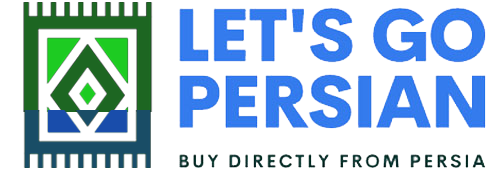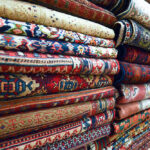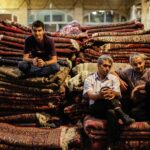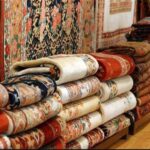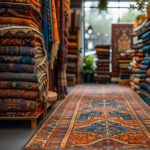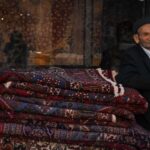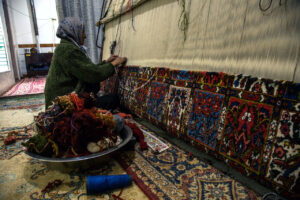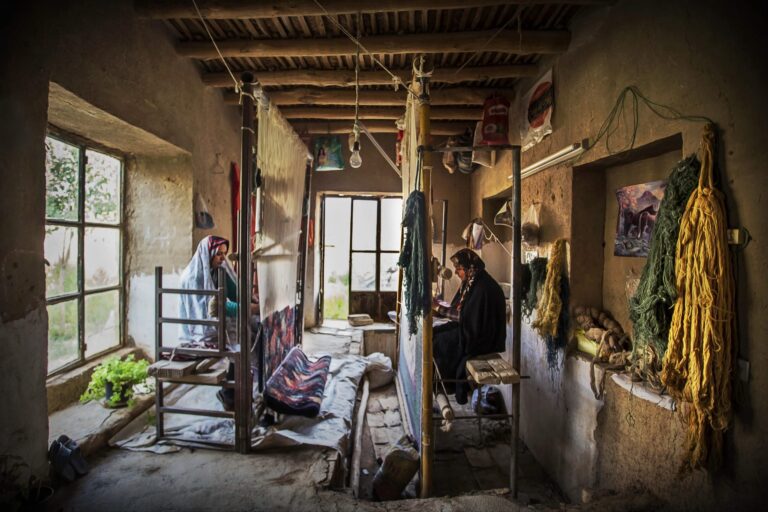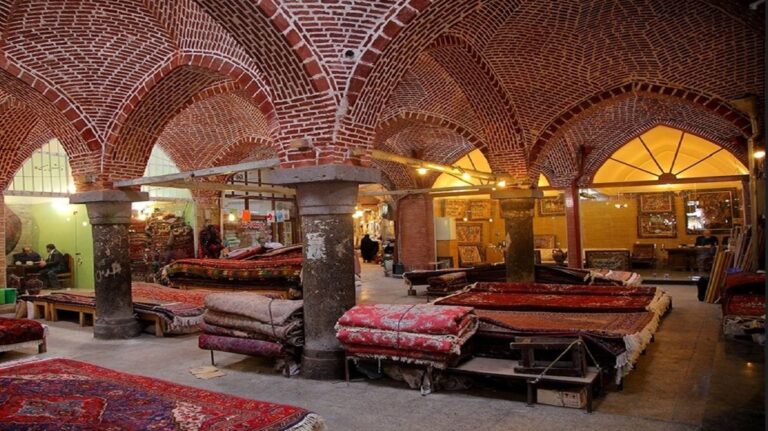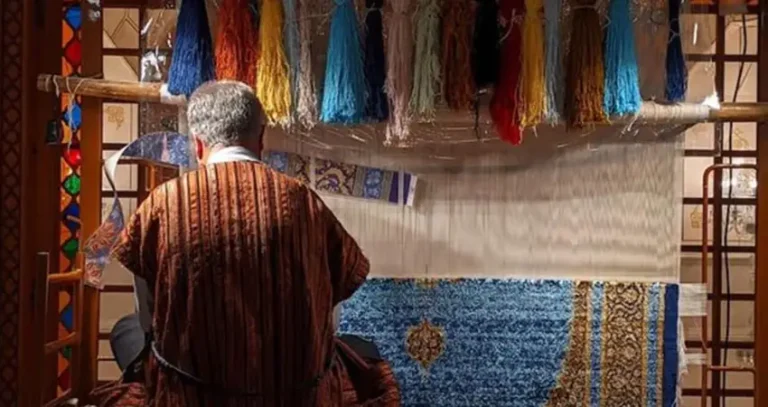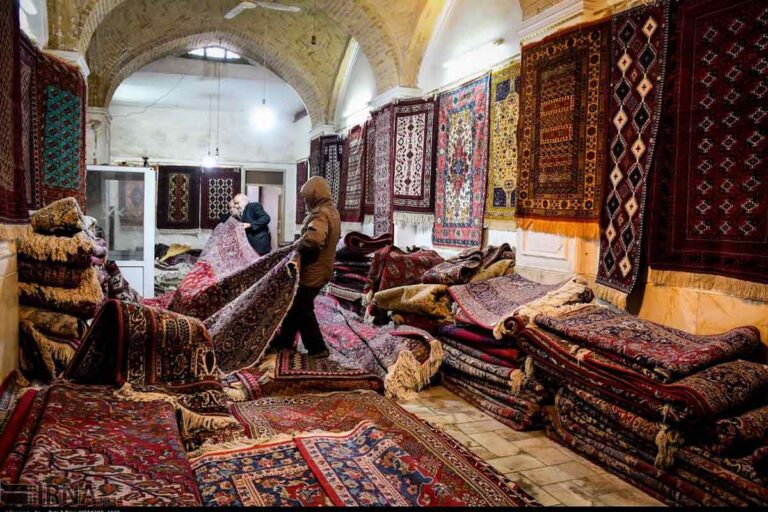Shaping Persian Rug Design Styles: Historical Influences Across Regions
Regional Motifs and Symbolism of Persian Carpet
The quality, appearance, and longevity of Persian rugs are defined not only by the intricate artistry behind their designs but also by the materials and construction techniques used in their creation. From the plush warmth of wool to the luminous elegance of silk and the steadfast durability of cotton, each material plays a crucial role in determining a rug’s character. In this post, we delve into the differences in materials and construction methods—exploring how they contribute to the quality and appearance of rugs from various regions of Iran, including Tabriz, Kashan, Nain, Qom, Isfahan, Kerman, Ardabil, Qazvin, Shiraz, Yazd, Sanandaj, Bijar, Mashhad, and Zanjan.
Core Materials: Wool, Silk, and Cotton
Wool: The Versatile Foundation
Characteristics:
-
Durability and Warmth: Wool is prized for its resilience and soft, insulating qualities, making it ideal for everyday use.
-
Natural Dye Affinity: Wool fibers absorb dyes well, resulting in rich, earthy tones that evoke traditional aesthetics.
-
Knotting Efficiency: Its fibrous structure is perfect for achieving high knot densities, essential for detailed designs.
Regional Insights:
-
Tabriz & Kashan: High-quality wool is essential in these regions for creating bold, intricate patterns and vibrant color schemes.
-
Nain: Rugs here often use fine wool to support minimalist designs, offering a subtle, refined texture that enhances the overall elegance.
Silk: The Epitome of Luxury
Characteristics:
-
Lustrous Finish: Silk imparts a luxurious sheen and smooth texture, enhancing both the visual and tactile appeal of a rug.
-
Intricate Detailing: Fine silk fibers allow for exceptional knot density, enabling the creation of minute, detailed motifs.
-
Lightweight Rarity: Silk rugs are generally lighter and rarer, often considered high-end collector’s items or statement pieces.
Regional Insights:
-
Qom & Isfahan: These areas are celebrated for their silk rugs, which often feature intricate calligraphy and symbolic patterns that exude spiritual and imperial grandeur.
-
Kerman: In Kerman, silk is used to accentuate focal points in otherwise predominantly woolen rugs, adding depth and contrast to complex pictorial scenes.
Cotton: The Steadfast Support
Characteristics:
-
Structural Backbone: Cotton is primarily used for the warp and weft, providing a strong, stable foundation that holds the rug’s pile.
-
Neutral Versatility: Its neutral texture allows the beauty of wool or silk piles to stand out without distraction.
-
Cost-Effective Durability: Cotton is an economical choice that enhances the longevity of a rug while keeping maintenance manageable.
Regional Insights:
-
Ardabil & Qazvin: High-quality cotton underlays in these regions ensure that even the most intricate designs retain their clarity over time.
-
Mashhad & Zanjan: In these areas, cotton provides the reliable support needed for rugs that combine both traditional motifs and innovative designs.
Regional Variations in Material Use and Construction
Tabriz and Kashan: Celebrating Robust Craftsmanship
Construction Techniques:
-
Materials: Premium hand-spun wool on a durable cotton foundation.
-
Design Impact: High knot densities support bold, geometric, and floral patterns that tell stories of ancient trade routes and cultural interactions.
-
Additional Note: These rugs are often celebrated for their ability to combine durability with striking visual appeal, making them popular in both traditional and modern interiors.
Nain and Qom: Refinement Meets Spiritual Expression
Construction Techniques:
-
Materials: Delicate wool—sometimes enriched with silk accents—supported by cotton foundations.
-
Design Impact: Nain rugs exhibit minimalist, subtle patterns with high precision, while Qom rugs often showcase intricate, sacred designs with higher knot densities.
-
Additional Note: The use of silk in Qom enhances the meditative and devotional motifs, creating rugs that serve as both decorative art and spiritual symbols.
Isfahan and Kerman: Luxurious Synthesis and Artistic Innovation
Construction Techniques:
-
Materials: A harmonious blend of wool and silk, often layered on a robust cotton base.
-
Design Impact: Isfahan rugs capture imperial splendor through lavish, multi-layered designs that echo the city’s architectural masterpieces. Kerman rugs, meanwhile, are known for their eclectic and sometimes pictorial designs, where silk highlights enhance narrative detail.
-
Additional Note: These regions push the boundaries of traditional craftsmanship, balancing ornamental complexity with technical mastery.
Ardabil, Qazvin, and Mashhad: A Testament to Durability and Heritage
Construction Techniques:
-
Materials: High-quality wool is paired with strong cotton foundations to ensure longevity.
-
Design Impact: Ardabil rugs are renowned for their timeless, historical motifs, while Qazvin rugs reflect regal influences with intricate detailing. In Mashhad, where the spiritual and cultural narratives are strong, the materials work together to produce robust yet refined pieces.
-
Additional Note: These rugs are built to endure, preserving the cultural heritage and artistic traditions of their regions over generations.
Shiraz, Yazd, and Sanandaj: The Intersection of Poetic Expression and Cultural Identity
Construction Techniques:
-
Materials: A varied mix—Shiraz often uses a combination of wool and silk for expressive, dynamic patterns, Yazd employs durable wool to reflect its desert-inspired designs, and Sanandaj incorporates ethnic flair with vibrant color variations on a sturdy cotton base.
-
Design Impact: Each region offers a unique narrative: Shiraz captures the poetic and dramatic flair of its cultural renaissance, Yazd embraces the minimalist beauty of arid landscapes, and Sanandaj tells stories of Kurdish heritage through bold, lively motifs.
-
Additional Note: These rugs often serve as cultural ambassadors, with materials and techniques that speak to the environmental and historical contexts of their regions.
Bijar and Zanjan: Rugged Durability and Historical Simplicity
Construction Techniques:
-
Materials: In Bijar, robust wool combined with a resilient cotton structure is essential to create the famously durable, rustic rugs that withstand the rigors of rural life. Zanjan rugs, on the other hand, emphasize clean, geometric patterns that reflect both historical simplicity and evolving artistic trends, often achieved with high-quality wool on a cotton base.
-
Design Impact: Bijar rugs are known for their rugged patterns and earthy hues, while Zanjan offers a refined blend of historical influences and contemporary design.
-
Additional Note: Both regions highlight the balance between functionality and aesthetic appeal, ensuring that traditional craftsmanship meets modern durability requirements.
The Intersection of Material and Technique
The choice of materials in Persian rug construction is deeply connected with the weaving techniques employed by master artisans. High knot densities achievable with fine wool or silk allow for intricate and expressive designs, while the cotton foundation provides the necessary strength and stability to support these detailed patterns. Each material is selected not only for its inherent properties but also for how it interacts with the region’s climate, cultural traditions, and artistic visions.
Conclusion
The art of Persian rug making is a delicate interplay between material selection and construction techniques. Whether it’s the enduring warmth of wool, the luxurious sheen of silk, or the steadfast support of cotton, each component contributes to the overall quality and beauty of these timeless textiles. From the bustling urban centers of Tabriz and Kashan to the spiritually rich hubs of Qom and Isfahan, and from the rugged landscapes of Bijar and Zanjan to the culturally vibrant regions of Shiraz, Yazd, and Sanandaj, every rug is a testament to the skill, innovation, and heritage of its creators.
By examining the material and construction variations across these diverse regions, we gain a deeper appreciation for the intricate artistry that transforms simple fibers into enduring masterpieces. Each Persian rug is more than a decorative piece—it is a woven narrative that embodies centuries of cultural legacy, technical ingenuity, and the timeless beauty of human creativity.
